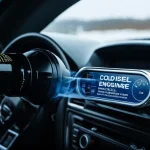Essential Brake Disc Maintenance for Rainy UK Winters
Rainy season maintenance is crucial for brake disc care, especially in the UK where winter driving often exposes vehicles to wet and slippery conditions. Regular brake inspections help detect wear, corrosion, and moisture buildup that can impair brake performance. Moisture and road salt accelerate brake disc rust and reduce friction, making effective brake disc maintenance vital to maintain reliable stopping power.
UK motorists face unique challenges during the rainy season. Puddles, slushy roads, and wet surfaces increase braking distances and risk of skidding. Brake discs exposed to consistent dampness tend to develop surface corrosion, which may cause vibrations or noise when braking. Ignoring these signs can compromise road safety during winter driving.
Also read : Become a pro at shifting gears in uk cars: expert tips for smooth and skillful manual driving
To ensure safe driving, drivers should schedule frequent brake checks, especially before and during winter rains. Cleaning brake discs to remove debris and moisture helps maintain their integrity. Additionally, using brake pads compatible with wet conditions enhances grip and response. Proper brake disc care not only prolongs part life but significantly improves vehicle control under challenging rainy UK winter conditions. This maintenance approach supports confident and safer journeys through the wettest seasons.
Common Brake Disc Issues in Wet and Cold Conditions
Rain, moisture, and cold weather significantly contribute to brake disc problems. When exposed to water, brake discs can develop surface rust quickly. This rust often forms overnight or during periods of humidity. While typically superficial, it can cause uneven braking and squealing noises until the rust is worn away by regular use.
In parallel : The definitive british handbook: expert techniques for perfecting paint protection with polishing and waxing
Low temperatures further exacerbate winter car issues by making brake components less flexible. Cold metal contracts and brake fluid may thicken, reducing responsiveness. This can result in longer stopping distances or a spongy brake pedal feel. Drivers should remain vigilant for these subtle changes in braking performance.
Key signs of brake wear and damage include:
- Persistent squeaking or grinding sounds
- Reduced braking efficiency or pedal vibration
- Visible grooves or scoring on discs
Identifying these symptoms early helps prevent costly repairs and maintains safety during wet and cold conditions. Regular inspection and rust prevention measures are vital in safeguarding your vehicle’s braking system through winter months.
Actionable Tips for Protecting Brake Discs From Moisture
Small but crucial steps to keep brakes resilient
Protecting brake discs from moisture is essential to maintain braking performance and extend their lifespan. Moisture prevention starts right after driving in wet conditions, where following proper cleaning routines helps remove water and dirt buildup before it causes corrosion. Use a soft brush or microfiber cloth to gently clean the discs, avoiding abrasive tools that might damage the surface.
To prevent rust buildup on brake surfaces, regularly inspect discs and apply anti-corrosion treatments designed for automotive brakes. These products create a protective layer that repels moisture effectively. Parking your vehicle in covered or dry areas also aids in reducing exposure to humidity.
When quick drying of brake components is needed, softly braking at low speed immediately after encountering water on the roads helps generate heat through friction, evaporating moisture swiftly. This simple driving technique can be a practical addition to your brake care tips. Additionally, avoiding prolonged stops in damp environments diminishes moisture accumulation.
Incorporating these moisture prevention methods ensures optimal brake performance and safety, safeguarding your investment over time.
Recommended Maintenance Routines for Winter Car Brakes
Practical tips to keep your brakes reliable and safe
Winter maintenance for car brakes is essential due to harsh road conditions and moisture exposure. Establishing a brake inspection schedule helps prevent unexpected failures. Experts recommend checking your brakes at least once every three months during the rainy and snowy seasons. This frequency ensures you’re promptly aware of wear or corrosion that winter moisture can accelerate.
At-home brake disc care can be effective if done correctly. Begin with visually inspecting your discs for rust or grooves. Clean the surface gently with a brake cleaner spray and a soft brush to remove dirt and salt residue. Check brake pads for thickness—worn pads below 3mm should be replaced immediately. Also, listen for unusual squeaking or grinding sounds during braking.
Knowing when to seek professional brake servicing is crucial. If you detect pulsations in the pedal, uneven braking, or warning lights, consult a mechanic without delay. Professionals can perform in-depth checks including brake fluid condition, caliper function, and rotor alignment, ensuring your routine brake care is comprehensive and safe. Following this plan will keep your brakes responsive all winter long.
Choosing Products and Safety Equipment for UK Wet Roads
When navigating the UK’s often wet roads, selecting the right brake maintenance products is crucial for safety and performance. Using recommended cleaners and anti-corrosion sprays can significantly enhance brake effectiveness by preventing rust and ensuring smooth brake pad contact.
For wet conditions, choosing weather-appropriate brake pads and discs is equally vital. Brake pads designed for damp environments provide better grip and shorter stopping distances. Additionally, discs resistant to water-induced wear maintain consistent braking, helping drivers control their vehicles confidently in slippery conditions.
Reliable tyres are indispensable on UK roads, especially when wet. Tyres with deep treads and water-dispersing designs reduce hydroplaning risks and improve grip. Pairing these with well-maintained car care equipment—such as tyre pressure gauges and tread depth tools—ensures optimal tyre performance.
Finally, integrating essential safety gear UK roads requirements, including reflective vests and emergency brake warning signs, supports safety during unforeseen stops or breakdowns in wet weather. Prioritizing these products and equipment will help drivers maintain control and stay safe on wet UK roads.
Expert Advice and Precautions for Safe Winter Motoring
Prioritize safety in wet winter conditions
Winter road safety demands extra attention, especially on often slick and wet UK roads. Experts consistently warn that reduced traction in cold, wet conditions increases stopping distances and the risk of skidding. To stay safe, drivers should follow key UK driving precautions:
- Slow your speed and maintain greater distance from vehicles ahead.
- Avoid sudden steering or braking to reduce the chance of losing control.
- Ensure your brakes are in top condition; this is crucial during winter months when wet roads amplify stopping challenges.
UK automotive professionals stress the importance of regular brake checks. Problems such as worn pads or moisture-affected components can significantly impair braking performance. For peace of mind, schedule professional brake inspections before the winter season intensifies.
Professional garages and authorized service centres across the UK offer comprehensive brake inspections and repairs. Prioritize places with excellent reviews and certified technicians. Checking your brakes early can prevent accidents and save lives, making these precautions indispensable for winter motoring.


